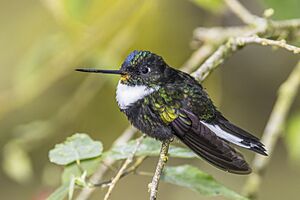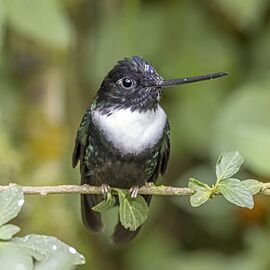Collared inca facts for kids
Quick facts for kids Collared inca |
|
|---|---|
 |
|
| male C. t. torquata, Colombia | |
 |
|
| female C. t. torquata, Colombia | |
| Conservation status | |
| Scientific classification | |
| Genus: |
Coeligena
|
| Species: |
torquata
|
 |
|
The collared inca (Coeligena torquata) is a type of hummingbird. You can find it in the wet Andean forests. These forests stretch from western Venezuela through Colombia and Ecuador all the way to Peru.
This hummingbird is easy to spot because of its bright white patch on its chest. It also has white feathers on its tail. Like other hummingbirds, it gets its energy by drinking nectar from flowers, especially from plants called bromeliads. When it drinks, it helps the plant by pollinating it. For protein, the collared inca eats small insects and other tiny creatures. It usually likes to be alone and can be seen flying at different heights, often out in the open.
Contents
About the Collared Inca
Hummingbirds are amazing birds! The collared inca belongs to a group called "typical hummingbirds." Some scientists group hummingbirds with swifts in an order called Apodiformes. Other scientists think hummingbirds and swifts belong to a different order called Caprimulgiformes.
Different Kinds of Collared Incas
Collared incas living in different areas can look a bit different. These small differences mean they are grouped into separate subspecies. Scientists are still figuring out the exact family tree for these birds.
The International Ornithological Committee (IOC) and the Clements taxonomy recognize five main subspecies:
- C. t. torquata: Found in Colombia, the eastern side of the Andes in Ecuador, and parts of Peru.
- C. t. fulgidigula: Lives on the western side of Ecuador. These birds are greener than the typical ones. Males have a shiny blue patch on their forehead and a metallic turquoise chin.
- C. t. margaretae: Found in the central Amazonas Region of Peru down to the Pasco Region. Males have a two-part forehead patch that shines green and blue. Females have a chin with white and green spots.
- C. t. insectivora: Lives from the Pasco Region to the Ayacucho Region of Peru.
- C. t. eisenmanni: Found in a small area northwest of Cusco, Peru. Both males and females have some coppery feathers on their upper tail. Males have a black head, except for the top part. Females have a reddish-brown chin.
Some other groups, like the South American Classification Committee (SACC), include more subspecies. They consider some of these as separate species, like the green inca and Gould's inca.
What They Look Like
The collared inca is about 10–14 centimetres (3.9–5.5 in) long. It has a fairly long, straight, black beak that is about 3–3.5 centimetres (1.2–1.4 in) long.
Most of the time, the C. t. torquata looks black. But it has a very large and easy-to-see white patch on its chest. If the light is just right, you can see more details. Males have a shiny metallic violet patch on their forehead and a shimmering green throat. Females have a duller throat with some white. Both sexes have white feathers on their thighs and dark green mixed into their black body feathers.
The tail of both male and female birds is black. However, the outer four tail feathers are white on the bottom half. Females are a bit lighter green overall than males and have a slightly smaller chest patch.
Collared incas don't make much noise. They sometimes make a quiet, low whistle that sounds like "tu-tee." They can also make a longer series of "pip... pip..." sounds. When they are looking for food, they make a very quiet spitting sound.
Where They Live
These hummingbirds live in humid subtropical and temperate forest areas. This includes cloud forests on both sides of the Andes mountains. Their range stretches from Venezuela to Bolivia. They usually live at heights between 1,800 metres (5,900 ft) and 3,000 metres (9,800 ft), often above 2,100 metres (6,900 ft) in Ecuador.
They usually look for food below the middle height of the forest canopy. You can often find them near thick bushes at the edge of the forest. The collared inca is quite common in most places where it lives. There are no major worries about its numbers right now.
How They Behave
What They Eat
Like all hummingbirds, the collared inca gets most of its energy from nectar. It drinks nectar from flowers, and in return, it helps to pollinate the flowers. For protein, it eats insects and other small insect-like creatures. They seem to really like plants that grow on other plants, called epiphytes.
The collared inca is a solitary bird. This means it looks for food alone. It flies a regular route between several flowers, visiting them one by one. This way of feeding is called "trap-lining."
Raising Young
Scientists have seen two female Coeligena hummingbirds (a related species) each taking care of two babies. Their nests were about 1–2 metres (3.3–6.6 ft) above the ground. The nests were about 7 centimetres (2.8 in) tall and wide, with a cup inside about 3 centimetres (1.2 in) deep and wide. They were made of soft seed fluff and other plant materials.
The eggs were completely white and measured about 1.5 by 1 cm. The mother bird would visit the nest once or twice every hour. She would feed her young for about 9 to 55 seconds each time.
Conservation Status
The IUCN (International Union for Conservation of Nature) has listed the collared inca as a species of "Least Concern." This means they are not currently in danger of extinction. They live across a large area, but their exact population size isn't known. Scientists believe their numbers might be slowly decreasing, but no immediate threats have been found.




